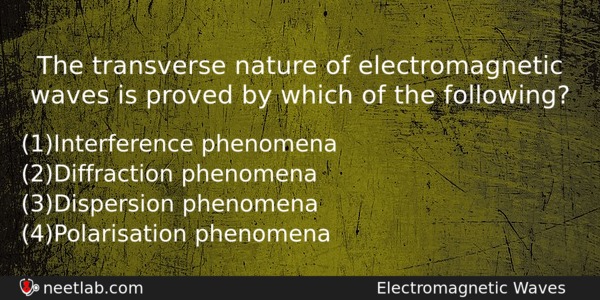| ⇦ | 
| ⇨ |
The transverse nature of electromagnetic waves is proved by which of the following?
Options
(a) Interference phenomena
(b) Diffraction phenomena
(c) Dispersion phenomena
(d) Polarisation phenomena
Correct Answer:
Polarisation phenomena
Explanation:
No explanation available. Be the first to write the explanation for this question by commenting below.
Related Questions: - A thin equiconvex lens of refractive index 3/2 and radius of curvature 30 cm
- If sink is at a temperature of -39⁰C and source at 0⁰C, then efficiency will be
- A deutron is bombarded on ₈O¹⁶ nucleus and α-particle is emitted. The product nucleus is
- A spring balance is attched to the ceiling of lift.A man hangs his bag on the string
- A speeding motorcyclist sees traffic jam ahead him. He slows down to 36 km per hour
Topics: Electromagnetic Waves
(28)
Subject: Physics
(2479)
Important MCQs Based on Medical Entrance Examinations To Improve Your NEET Score
- A thin equiconvex lens of refractive index 3/2 and radius of curvature 30 cm
- If sink is at a temperature of -39⁰C and source at 0⁰C, then efficiency will be
- A deutron is bombarded on ₈O¹⁶ nucleus and α-particle is emitted. The product nucleus is
- A spring balance is attched to the ceiling of lift.A man hangs his bag on the string
- A speeding motorcyclist sees traffic jam ahead him. He slows down to 36 km per hour
Topics: Electromagnetic Waves (28)
Subject: Physics (2479)
Important MCQs Based on Medical Entrance Examinations To Improve Your NEET Score
18000+ students are using NEETLab to improve their score. What about you?
Solve Previous Year MCQs, Mock Tests, Topicwise Practice Tests, Identify Weak Topics, Formula Flash cards and much more is available in NEETLab Android App to improve your NEET score.
Share this page with your friends

Leave a Reply